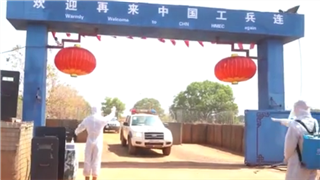BEIJING, Feb. 21 (Xinhua) -- The Communist Party of China (CPC) on Saturday launched a campaign on Party history learning and education among all Party members.
Founded in 1921, the CPC has grown into the world's biggest Marxist ruling party with over 91 million members in a century. It has been in power for over 70 years in China, the world's largest socialist country.
Xi Jinping, general secretary of the CPC Central Committee, has set great store by history. He particularly emphasizes the revolutionary history, describing it as "the best textbook" for Chinese Communists.
Over the past eight years, Xi, also Chinese president and chairman of the Central Military Commission, has paid several visits to places bearing milestone significance in the Party's history.
The visits represent the CPC's efforts to rediscover the strength it needs in its unwavering quest for national rejuvenation.
SHANGHAI & ZHEJIANG -- where it all started
In October 2017, the CPC leadership, led by Xi, visited a boat replica in east China where the Party's dream set sail.
In 1921, CPC founders attending the Party's first national congress were forced to leave a small building in the French concession area of Shanghai. They boarded a boat on Nanhu Lake in Jiaxing, Zhejiang Province to continue the congress proceedings.
Visiting the Shanghai and Jiaxing sites, Xi said the aim of the tour was to review the Party's history -- particularly its founding -- to follow the lofty ideals of these predecessors.
"The original aspiration of the CPC members must never change," Xi reminded CPC cadres. He added that only in this way could the Party maintain popular support and accomplish its deeds with an indomitable will.
JIANGXI -- where the epic Long March began
In 2019, Xi chose east China's Jiangxi Province, where the Central Red Army began the Long March in the 1930s, to call for a "new Long March."
In October 1934, Red Army soldiers launched the most epic military maneuver in China's modern history, trekking about 12,500 kilometers across the country.
Describing Jiangxi as a land full of revolutionary history and memories, Xi called for a deep understanding of the hard-earned establishment of the political power of the CPC, the People's Republic of China (PRC), and socialism with Chinese characteristics. He demanded more efforts to carry forward the revolutionary spirit and traditions.
Paying tribute to a monument in Yudu County marking the start of the Long March, Xi noted that China is on a "new Long March." He said the country would depend on the firm faith and strong will of the whole Party and all people to overcome significant challenges at home and abroad and secure new victories in building socialism with Chinese characteristics.
GUIZHOU -- where the Party was saved at the most perilous moment
In June 2015, Xi visited Zunyi in southwest China's Guizhou Province, where the Zunyi Meeting -- "a watershed event in the history of the CPC" -- took place.
The CPC convened the meeting in January 1935, when the Party, the Red Army, and the Chinese revolution -- in Xi's words -- were "saved at the most perilous moment."
Amid severe setbacks at the early stage of the Long March, the meeting established Comrade Mao Zedong as the leader of the CPC Central Committee and the Red Army, heralding a new chapter in history in which the CPC independently solved problems occurring in the Chinese revolution.
Xi visited Guizhou this year again, just ahead of the Chinese New Year. There he reiterated the Party's revolutionary past.
Of all the places the Red Army reached, it spent the longest time and had the most extensive presence in Guizhou, leaving later generations an enduring spiritual legacy, Xi said.
The Zunyi Meeting's distinct features, including the establishment of the correct CPC Central Committee leadership, as well as innovative formulation and implementation of strategies that suited the Chinese revolution's characteristics, still have significance today, he added.
SHAANXI -- where the Party legacy shines
Before the Chinese New Year of 2015, Xi revisited old revolutionary base areas in northwest China's Shaanxi Province. The trip included iconic Yan'an -- the CPC base during the 1930s-40s after the Long March.
Xi called Yan'an a shrine for the Chinese revolution. There, the CPC-led revolutionary cause transited from its low tide to high tide.
He said the excellent conduct of the older generation of revolutionaries and Chinese Communists in Yan'an has left a precious legacy for the Party.
The "Yan'an Spirit" entails sticking to the correct political orientation, whole-heartedly serving the people, working hard in a spirit of self-reliance, among others.
Xi said strength should be drawn from the "Yan'an Spirit" to ensure full and strict governance over the Party.
BEIJING -- where the Party emerged victoriously
In September 2019, Xi visited a revolutionary memorial site in the Fragrant Hills in suburban Beijing ahead of the 70th founding anniversary of the PRC.
In March 1949, the CPC Central Committee made the Fragrant Hills its headquarters for half a year, where the Party led the Chinese People's War of Liberation to a countrywide victory.
It marked the shift of the Chinese revolution's focus from the countryside to urban areas, Xi said, adding that this period holds a very important position in the history of the Party and the PRC.
Xi said that commemorating this part of history is to inherit the spirit of carrying through reforms, being devoted to the people and public service, guarding against arrogance and impetuosity, and working hard.
"We must be clear-headed and determined as preparing for tough tests to deliver performances that can withstand the test of time in the new era," Xi said.











